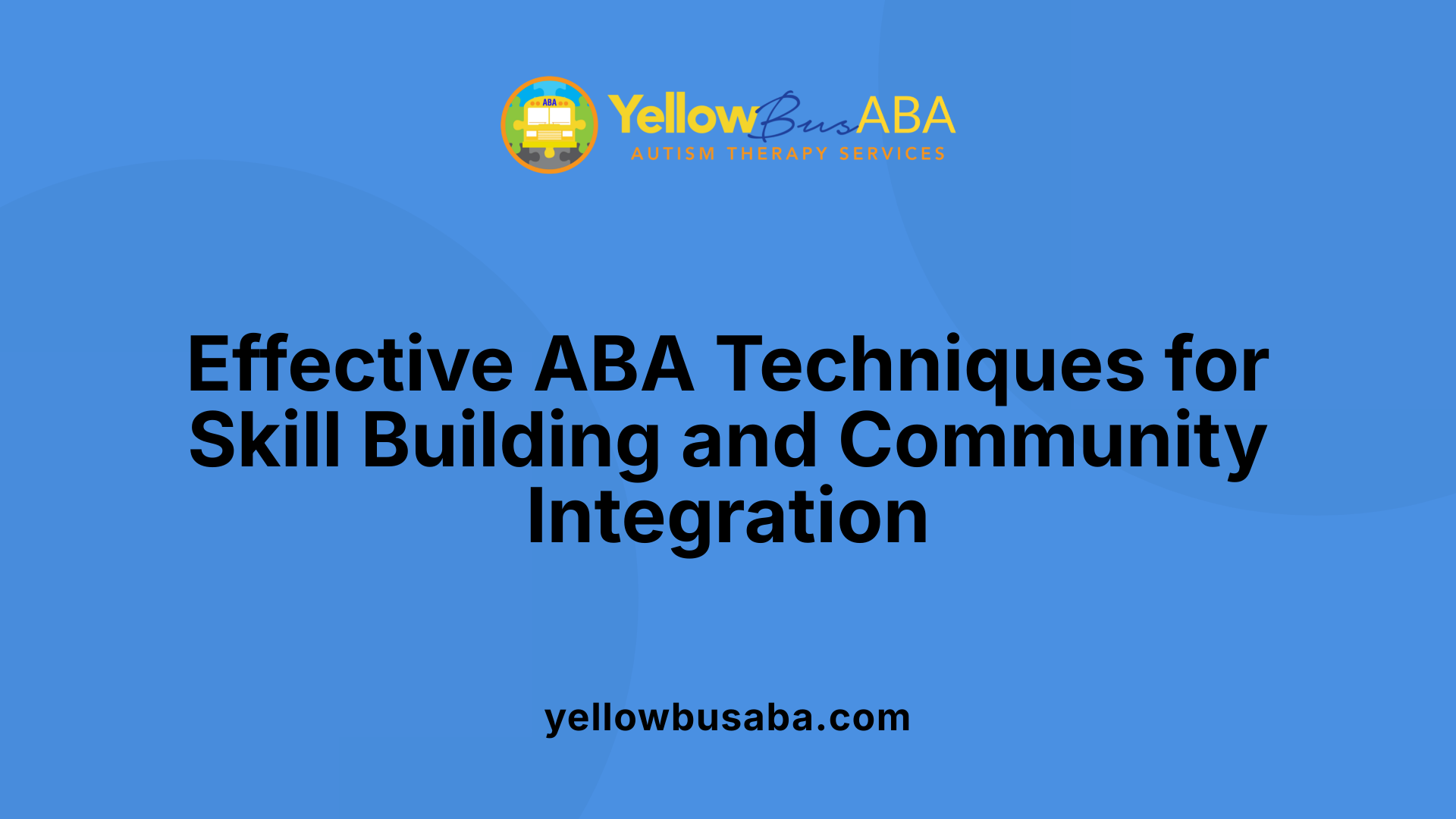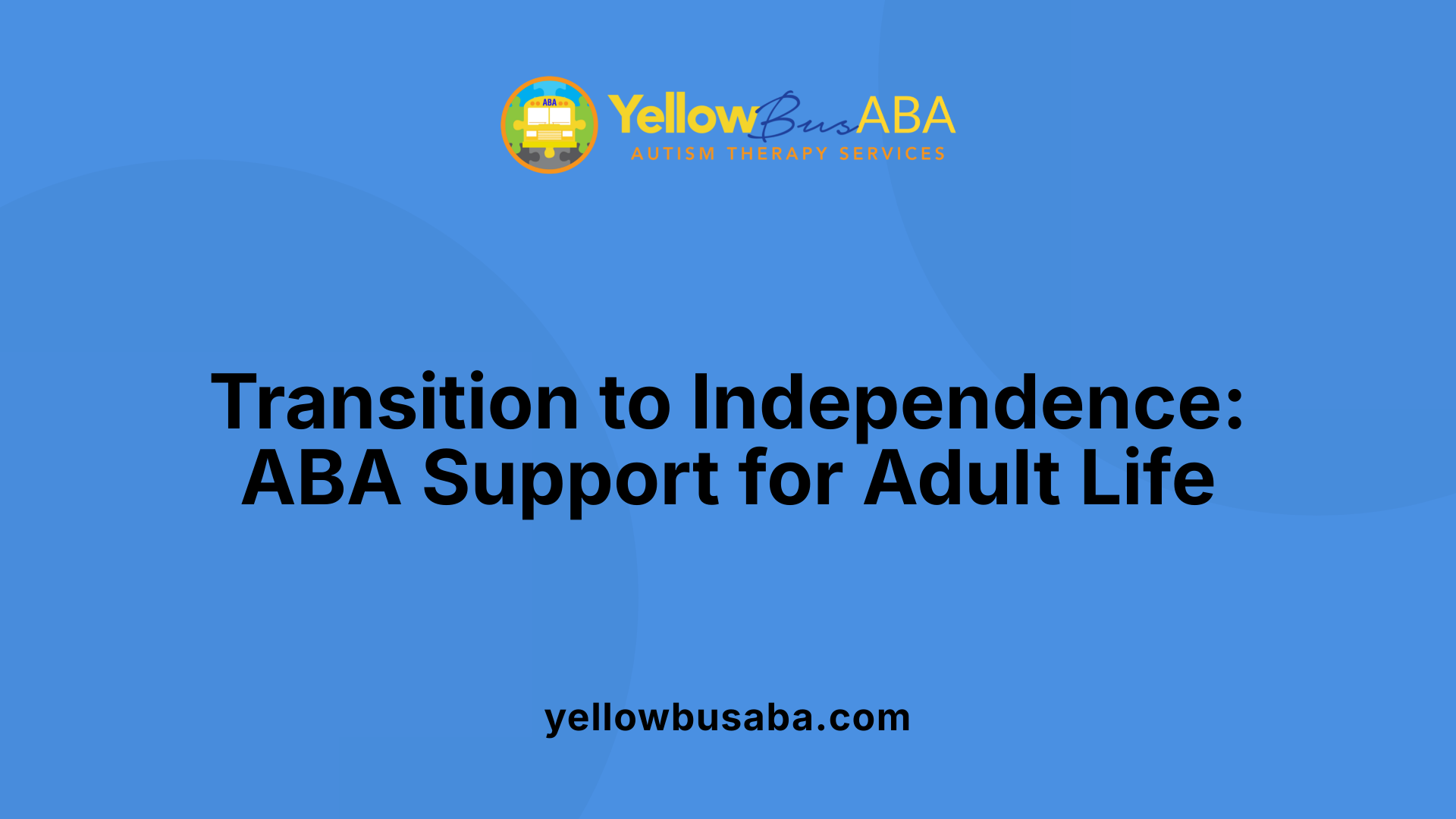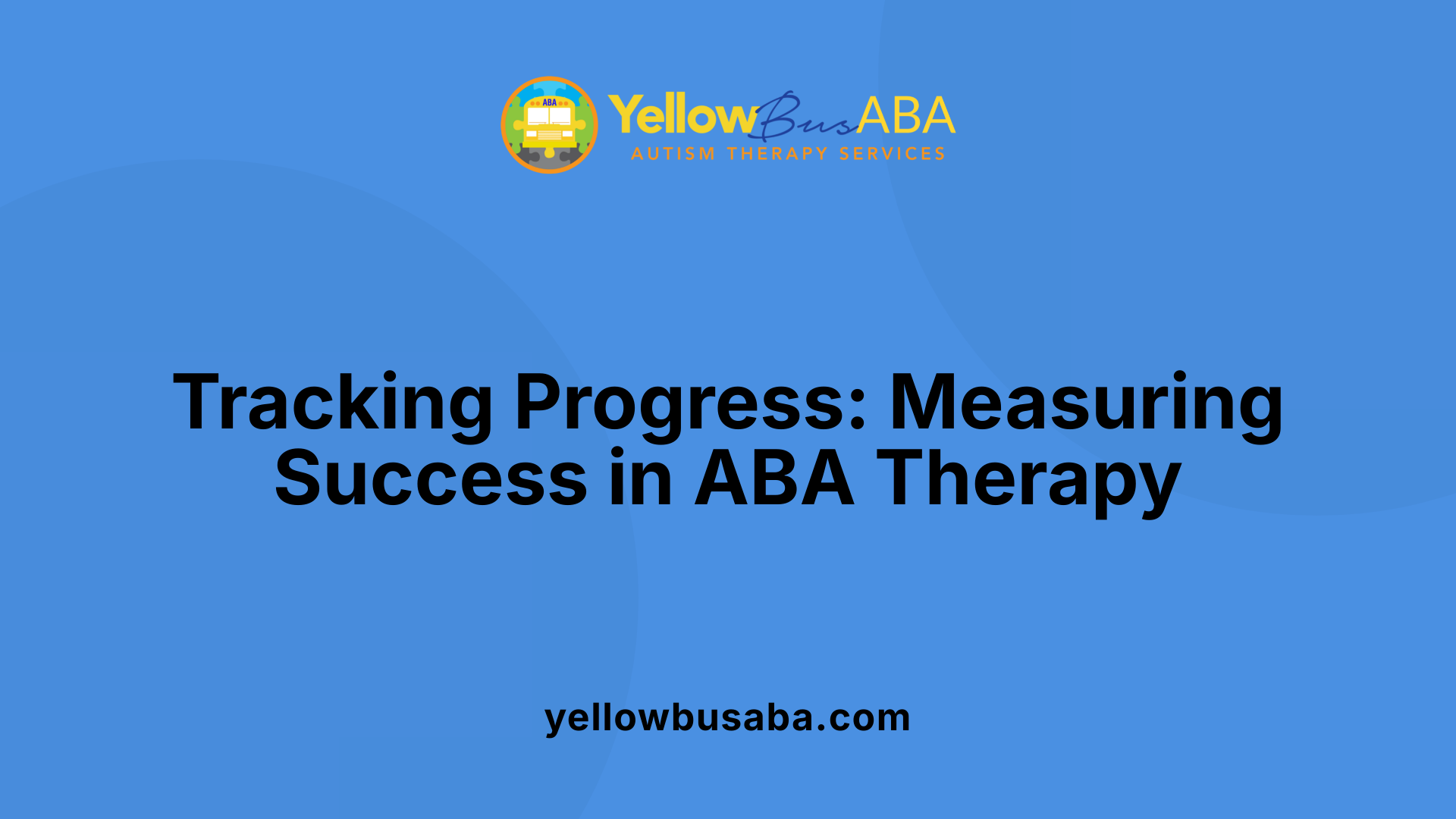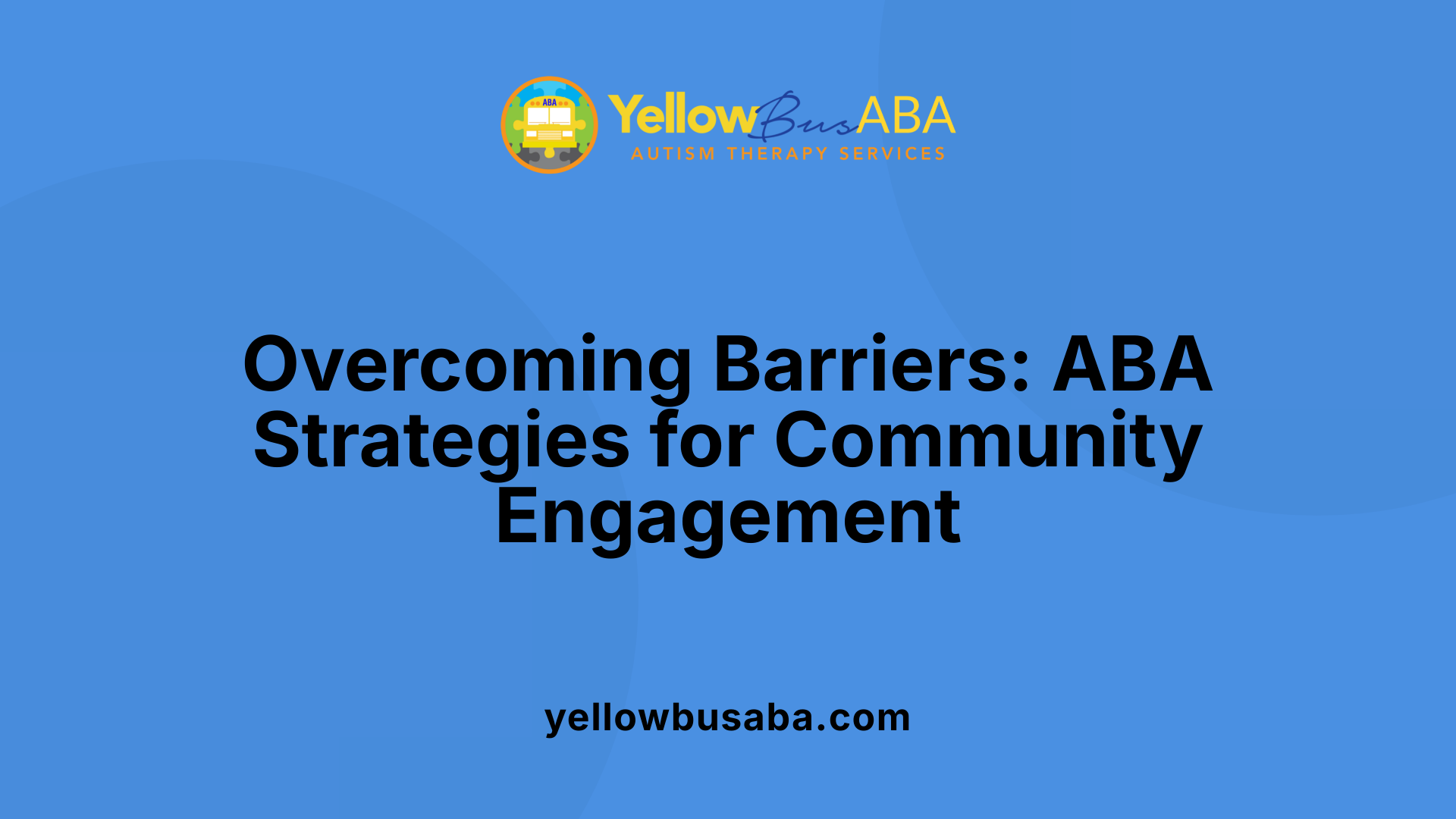How Young Adult ABA Therapy Prepares Individuals for Community Engagement
August 18, 2025
Building Bridges: The Role of ABA in Empowering Young Adults for Community Life

Unlocking Community Potential through ABA Therapy
Autism spectrum disorder (ASD) presents unique challenges and opportunities for young adults striving for independence and community engagement. Applied Behavior Analysis (ABA) therapy emerges as a proven, evidence-based approach tailored to bolster essential skills, facilitate transition planning, and promote meaningful integration into society. This article explores how ABA therapy not only enhances communication, social, and daily living skills but also addresses barriers to community participation, ultimately fostering a more inclusive environment where young adults can thrive.
Foundations of ABA Therapy and Its Impact on Development
 Applied Behavior Analysis (ABA) is a scientifically supported approach that focuses on understanding and modifying behavior through evidence-based techniques. It helps children and adults with autism develop essential skills and addresses behavioral challenges by using positive reinforcement, task analysis, and data-driven assessments.
Applied Behavior Analysis (ABA) is a scientifically supported approach that focuses on understanding and modifying behavior through evidence-based techniques. It helps children and adults with autism develop essential skills and addresses behavioral challenges by using positive reinforcement, task analysis, and data-driven assessments.
ABA targets critical developmental areas such as communication, imitation, play, and self-care, which are fundamental for independent living and social interaction. By breaking down complex skills into manageable steps, therapy makes learning more accessible and effective. For example, children learn to initiate conversations, share interests, and interpret social cues, all of which foster stronger social bonds.
Early intervention is particularly impactful because young children’s brains are highly adaptable, a concept known as neuroplasticity. Intervening during this sensitive developmental period allows therapists to shape neural pathways positively, promoting skill acquisition and reducing symptoms of ASD. Implementing ABA early can significantly improve long-term outcomes, helping children reach milestones in language, self-help, and social skills.
In addition to supporting children, ABA therapy prepares young adults for community life. It emphasizes real-world practice, using community-based settings to teach skills for navigating public transportation, managing money, and crossing streets safely. Through role-playing, social stories, and reinforcement in natural environments, young adults gain the confidence and independence needed for meaningful community participation.
By consistently involving families and caregivers in training and support, ABA reinforces learning at home and across social settings. This collaborative approach ensures that skills are generalizable and integrated into daily routines, ultimately enabling individuals with ASD to lead more autonomous and fulfilling lives.
Techniques and Strategies in ABA for Skill Development

What methods and strategies are used in ABA therapy to develop skills for community integration?
ABA therapy utilizes a variety of proven techniques to help children with autism develop vital skills for engaging in the community confidently. Key methods include Discrete Trial Training (DTT), Pivotal Response Training (PRT), and Natural Environment Teaching (NET).
DTT involves breaking down skills into small, manageable steps and teaching them systematically with clear prompts and reinforcement. This structured approach helps children learn foundational skills like communication and self-care skills effectively.
PRT emphasizes pivotal areas such as motivation, response to multiple cues, and self-management. It encourages more natural and spontaneous learning opportunities, making it a practical approach for social interactions.
NET focuses on teaching skills in the child's natural surroundings, such as parks, grocery stores, or playgrounds. This method ensures that learning is relevant and can be generalized across different environments.
These techniques rely heavily on positive reinforcement, where desired behaviors are rewarded to increase their occurrence. Prompting helps guide children toward correct responses, while fading techniques gradually reduce prompts, fostering independence.
Assessment tools like the ABLLS (Assessment of Basic Language and Learning Skills) and Vineland Adaptive Behavior Scales help determine current abilities and identify areas for targeted growth. These assessments inform personalized intervention plans tailored to each child's strengths and needs.
Involving families through modeling, prompts, and training ensures that learned skills are practiced consistently at home and in various settings. Caregivers are trained to implement ABA strategies effectively, supporting skill generalization.
Overall, these combined strategies and assessments create a comprehensive framework that promotes community skills, from social interactions to daily living activities, enabling children with autism to navigate their environment more independently and confidently.
Preparing Young Adults for Real-World Engagement
 ABA therapy plays a vital role in equipping young adults with autism spectrum disorder (ASD) to navigate adult life and community settings confidently. It employs tailored strategies to teach functional communication skills, such as Functional Communication Training (FCT) and the Picture Exchange Communication System (PECS). These methods help individuals express their needs and interact effectively in everyday situations.
ABA therapy plays a vital role in equipping young adults with autism spectrum disorder (ASD) to navigate adult life and community settings confidently. It employs tailored strategies to teach functional communication skills, such as Functional Communication Training (FCT) and the Picture Exchange Communication System (PECS). These methods help individuals express their needs and interact effectively in everyday situations.
Furthermore, ABA focuses on developing safety awareness and understanding social cues. Young adults learn to recognize cues like body language and tone of voice, which are critical for safe and appropriate interactions.
Practicing essential community navigation skills is also a core component. These include crossing streets safely, managing money, using public transportation, and ordering food at a restaurant. Through systematic role-playing, real-life practice, and consistent reinforcement, ABA therapy fosters independence in these areas.
How does ABA therapy prepare young adults for community engagement and social participation?
ABA prepares young adults by teaching vital life skills in realistic settings. This involves activities like navigating stores, practicing safety behaviors, and engaging confidently with community members. The approach emphasizes emotional regulation, social competence, and effective communication, enabling individuals to participate fully and comfortably in their communities.
Family involvement is integral. Therapists often collaborate with caregivers to ensure skills learned in therapy are generalized and maintained at home and in community environments. This comprehensive approach promotes inclusion, independence, and the ability to build meaningful social relationships.
By integrating assessments, community-based practice, and individualized plans, ABA therapy helps young adults transition smoothly into adult life—empowering them to be active, engaged members of society.
Transition Planning and Skill Acquisition for Adulthood

What role does ABA therapy play in transition planning for young adults to support their community involvement?
ABA therapy is vital in preparing young adults with autism spectrum disorder (ASD) for a successful transition into independent adult life. It focuses on developing and strengthening essential skills such as social communication, daily living, and self-care, enabling individuals to navigate community routines confidently.
One of the primary aspects of transition is helping young adults master skills like using public transportation, managing money, and accessing employment opportunities. ABA programs create personalized, measurable goals that align with an individual's Transition Plan (ITP), ensuring targeted progress towards independence.
To ease anxiety related to changes, ABA employs visual supports and structured routines. These tools provide predictability and clarity, helping individuals feel more secure and capable during transitional phases. For instance, visual schedules can outline steps for using a bus or managing cash, reducing uncertainty and promoting successful community engagement.
Additionally, ABA therapy fosters independence in pursuing post-secondary education and employment. It includes teaching problem-solving, time management, and social skills necessary for workplace interactions and academic settings.
By integrating these approaches, ABA prepares young adults not only to participate actively in their communities but to do so with confidence and autonomy. This support ensures they can enjoy a higher quality of life and greater societal inclusion as they transition into adulthood.
Measuring Success and Outcomes of ABA Interventions
 Assessment tools such as the ABLLS (Assessment of Basic Language and Learning Skills) and Vineland Adaptive Behavior Scales are crucial in tracking progress for children receiving ABA therapy. These standardized measures help identify current abilities in communication, social skills, and daily living, guiding the development of personalized treatment goals. Regular assessment ensures interventions are effective and adapted to the individual’s growth.
Assessment tools such as the ABLLS (Assessment of Basic Language and Learning Skills) and Vineland Adaptive Behavior Scales are crucial in tracking progress for children receiving ABA therapy. These standardized measures help identify current abilities in communication, social skills, and daily living, guiding the development of personalized treatment goals. Regular assessment ensures interventions are effective and adapted to the individual’s growth.
Indicators of progress include increased independence, more frequent social interactions, and improvements in adaptive behaviors like self-care and community navigation. For example, a child's ability to cross streets safely or use money confidently reflects successful skill acquisition. Data collection during therapy sessions also helps measure these changes objectively.
Long-term societal benefits of ABA therapy are extensive. They include reduced healthcare costs due to fewer behavioral challenges and hospitalizations, as well as increased inclusion and acceptance within the community. When individuals develop essential life skills, they are better equipped to participate actively in everyday activities, pursue education or employment, and build relationships.
Overall, ABA therapy supports meaningful improvements in a person’s ability to live independently and engage socially. Consistent use of assessment tools and monitoring progress helps ensure continuous growth and success in transitioning from childhood to adulthood, enriching the individual’s quality of life and promoting societal integration.
Addressing Community Engagement Challenges through ABA

What challenges are faced in community engagement for young adults with autism, and how does ABA therapy address these challenges?
Engaging young adults with autism in community activities often presents several obstacles. These include difficulties with social communication, social anxiety, and trouble applying learned skills across different environments. Many individuals may feel overwhelmed by new social situations, resist unfamiliar activities, or exhibit challenging behaviors that hinder participation.
ABA therapy offers targeted interventions to overcome these hurdles. It emphasizes teaching necessary social skills, such as initiating conversations, interpreting social cues, and maintaining relationships, often through naturalistic and real-world scenarios. Techniques like peer interactions, role-playing, and visual supports are used within therapy sessions to make learning engaging and practical.
Family involvement plays a vital role in reinforcing these skills at home and in community settings. Therapists also work closely with community programs to create supportive environments that facilitate inclusion. Through consistent practice, reinforcement, and collaboration, ABA helps individuals gain confidence and independence in social settings, promoting smoother community engagement.
Overall, ABA therapy focuses on improving social functioning and adapting interventions to suit each individual’s needs, helping them participate more fully in community life.
The Transformative Impact of ABA on Social Integration and Community Life

How does ABA therapy improve social skills, peer interactions, independence, and confidence?
ABA therapy plays a vital role in enhancing social abilities in children and young adults with autism. Through targeted interventions, individuals learn essential skills such as initiating conversations, sharing, interpreting social cues, and maintaining peer relationships. These improvements foster greater independence and self-confidence.
ABA employs techniques like social skills training, role-playing, and reinforcement strategies to encourage positive social behaviors. As a result, individuals develop more meaningful interactions, which boost their confidence and reduce social anxiety.
How are community needs integrated into ABA programs and what cultural considerations are made?
Successful ABA programs recognize the importance of tailoring interventions to fit community contexts. By involving families and local institutions like schools and regional centers, programs become more culturally sensitive and responsive. This integration ensures that strategies are relevant and respectful of individual backgrounds, promoting better engagement and skill generalization.
Incorporating community-specific norms and providing support across different environments help individuals navigate real-world situations confidently. Families are trained to implement ABA techniques at home, creating consistency and easing transitions into the community.
What long-term benefits does ABA offer in terms of inclusion, quality of life, and societal impacts?
The long-term influence of ABA is profound. Early and intensive intervention can lead to enduring improvements in social engagement, independence, and daily life skills. These gains increase the chances of full inclusion in educational settings, workplaces, and community activities.
Research shows that individuals who receive ABA therapy often experience a better quality of life, with reduced behavioral challenges and enhanced emotional regulation. Societally, this translates into reduced healthcare costs, greater workforce participation, and more inclusive communities.
How are innovative approaches like technology and community-based strategies incorporated?
Recent advancements involve integrating technology such as apps, virtual reality, and interactive devices into ABA interventions. These tools make learning engaging and accessible, especially in community settings.
Community-based approaches expand ABA services beyond clinics, emphasizing real-world practice in homes, schools, and public areas. This practical exposure ensures skills are meaningful and transferable, supporting sustained social participation and community integration for autistic young adults.
Embracing Community Integration Through ABA
ABA therapy stands as a cornerstone in preparing young adults with autism for vibrant, engaged community lives. By fostering essential skills in communication, socialization, and daily living, and addressing transitional challenges effectively, ABA empowers individuals to navigate and thrive within their communities. As research and practice continue to evolve, the integration of innovative strategies and community collaborations promises an even brighter future—one where inclusion, independence, and meaningful participation are accessible to all young adults with autism.
References
- How ABA Therapy Can Benefit Both Children and Adults
- How ABA Therapy Helps with Daily Living Skills
- How ABA Therapy Can Benefit Children with Autism
- Preparing Your Child with Autism for Adulthood - AutismCOE
- The Power of Progress: Applied Behavior Analysis (ABA) Therapy ...
- Real Results: ABA Therapy's Impact in California Communities
- The Power of Early Intervention with ABA Therapy for Autism
- [PDF] The Impact of Applied Behavior Analysis on Children with Autism






